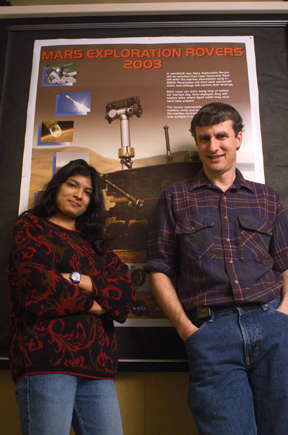Success of Mars Odyssey satellite puts key communications link in place for Cornell-led Rover mission in 2003
By David Brand

A collective sigh of relief could be heard around the corridors of Cornell University's Space Sciences Building late Tuesday night when the Mars Odyssey spacecraft went into orbit around Mars. The main reason for the jubilation: The small robotic spacecraft will be the key communications link for the Mars Exploration Rover (MER) mission in 2003.
"Everything went perfectly, and this is fabulous news for the Rover program," says Cornell Professor of Astronomy Steven W. Squyres, who has a leading role in both NASA's Odyssey and Rover missions. He is a member of the science team for the gamma ray spectrometer (GRS), one of three instruments carried by the Odyssey. And he is principal investigator, or leader, of the larger international team that is developing the Athena science package to be carried by the two Rover vehicles during their planned exploration of the red planet in 2004.
If the $300 million Odyssey mission had failed, the Rover program could have been seriously hampered, perhaps even jeopardized. That is because the two exploration vehicles would have had only the aging Global Surveyor spacecraft, which went into Mars orbit in September 1997, to provide communications with Earth. Now the two Rovers will be able to upload data -- in such areas as the mineral and element composition of rocks and soils -- to a state-of-the art communications package. The Odyssey relay antenna will then transmit the data to Cornell's Space Sciences Building.
Squyres has been associated with the gamma ray spectrometer instrument package on board Odyssey since 1986, well before the Mars Rover program was planned. However, the original landing of a single Rover was planned for this year, to coincide with the Odyssey mission, but was canceled by NASA. The $700 million MER mission was announced by the space agency in August last year, with launches planned for May and June, 2003, and landings on the planet for Jan. 4 and 5, 2004. Although the Odyssey's GRS will play an important role in determining the elements that make up the Martian surface, measuring the abundance and distribution of about 20 primary elements, Squyres does not expect the instrument to play a role in picking the landing sites for the two Rovers. However, another Odyssey instrument, THEMIS (thermal emission imaging system), is expected to provide data on minerals in soils and rocks that will aid understanding of the four potential landing sites chosen for the Rovers at a recent meeting at the Jet Propulsion Laboratory (JPL) in Pasadena, Calif. The sites were chosen on the basis of images from Global Surveyor and are areas where there is the best evidence possible that water was once present on the surface. Squyres describes the four sites as "fabulous," and says that the two final sites will be selected within six months.
The planning for the two Rovers, each a 300-pound mobile laboratory, is intense. Says Squyres, "The payload is going well. The schedule, overall, is tight. But we are going to make it."
A critical interpretation of the Odyssey GRS data also will be carried out at Cornell by graduate student Amena Siddiqi who is writing her doctoral thesis on the likely sources of ice on Mars. It is known that ice exists in the Martian polar regions, but it is not known if there is ice beneath the soil in other latitudes. The GRS can actually see through the planet's soil to deposits of ice below. Siddiqi, a British citizen who is a native of Pakistan, will use Odyssey data to develop maps that could show where the ice deposits exist.
The Odyssey GRS team leader is William Boynton of the University of Arizona. Both the Odyssey mission and the 2003 Rover projects are managed by JPL.
Media Contact
Get Cornell news delivered right to your inbox.
Subscribe